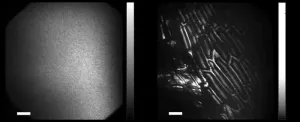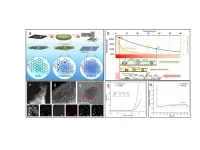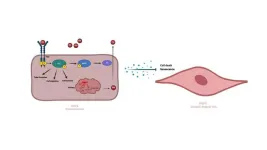(Press-News.org) All cancer mutations that cause drug resistance fall into one of four categories. New research has detailed each type, helping to uncover targets for drug development and identify potential effective second-line therapies.
In a new large-scale study, researchers from the Wellcome Sanger Institute, EMBL’s European Bioinformatics Institute (EMBL-EBI), Open Targets, and collaborators used CRISPR gene editing to map the genetic landscape of drug resistance in cancers, focusing on colon, lung, and Ewing sarcoma. The team explains how known mutations impact drug resistance and highlights new DNA changes that could be explored further.
The research, published today (18 October) in Nature Genetics, investigated the effect of mutations on the sensitivity to 10 cancer drugs, also identifying possible effective second-line treatments based on a person’s genetic makeup.
By understanding the mechanisms of how cancers become resistant to treatment, researchers can identify new targets for personalised therapies, help treat patients based on their cancer's genetic makeup, give second-line treatment options to those who currently have none, and help further research to develop next-generation cancer drugs that could avoid drug resistance emerging.
One of the major challenges in cancer treatment is drug resistance. Mutations in cancer cells mean that over time they become less responsive to therapies. After cancer has become resistant to the initial treatment, the following therapies are known as second-line therapies and options for these can be limited. Understanding what molecular changes are causing the resistance, and what can be done to tackle this, can help uncover new options and inform clinical pathways for specific mutations.
However, current methods for identifying drug-resistance mutations require multiple samples from patients collected over a long time, making this a time-consuming and difficult process.
To gather large-scale information on cancer mutations, the team from the Wellcome Sanger Institute, EMBL-EBI, Open Targets, and collaborators, used cutting-edge CRISPR gene editing and single-cell genomic techniques to investigate the impact of multiple drugs across human cancer cell lines and organoid cell models. By combining these techniques, researchers were able to create a map showing drug resistance across different cancers focusing on colon, lung, and Ewing sarcoma. The map uncovers more about the mechanisms of drug resistance, highlights DNA changes that may be potential treatment biomarkers, and identifies promising combination or second-line therapies.
The team found that cancer mutations fall into four different categories depending on the impact of the DNA change. Drug resistance mutations, otherwise known as canonical drug resistance mutations, are genetic changes in the cancer cell that lead to the drug being less effective. For example, changes that mean the drug can no longer bind to its target in the cancer cell.
Drug addiction mutations lead to some of the cancer cells using the drug to help them grow, instead of destroying them. This research supports the use of drug holidays in the case of drug addiction mutations, which are periods without treatment. This could help destroy the cancer cells with this type of mutation, as the cells are now dependent on the treatment.
Driver mutations are gain-of-function genetic changes that allow cancer cells to use a different signalling pathway to grow, avoiding the pathway that the drug may have blocked.
Lastly, drug sensitising variants are genetic mutations that make the cancer more sensitive to certain treatments and could mean that patients with these genetic changes in their tumour would benefit from particular drugs.
The research focused on colon, lung, and Ewing sarcoma cancer cell lines as these are all prone to developing resistance and have limited second-line treatments available. The team used 10 cancer drugs that are either currently prescribed or going through clinical trials to help highlight if any of these could be repurposed or used in combination to address resistance, decreasing the time it would take to get any potential treatments to the clinic.
Understanding more about the four different types of DNA changes can help support clinical decisions, explain why treatments are not working, support the idea of drug holidays in certain patients, and help develop new treatments. This knowledge also helps accelerate drug companies' research into next-generation cancer inhibitors that could better avoid drug resistance.
Dr Matthew Coelho, first author from the Wellcome Sanger Institute and Open Targets, said: “Cancer cells developing resistance to treatments is a huge problem, and having a rapid way to identify these mutations in patients and understand how to combat them is key to treating cancer. Our study details how mutations fall into four different groups, which might need different treatment plans. For example, if there are drug addiction mutations, taking a break from treatment may help. By using cutting-edge genetic techniques, we have started to build a large-scale and rapid way to understand drug resistance and hopefully find new targets for second-line treatments.”
Dr Magdalena Strauss, study author previously of EMBL’s European Bioinformatics Institute (EMBL-EBI) and now at the University of Exeter, said: “By combining cutting-edge CRISPR gene editing and single-cell techniques with statistical machine learning, we have been able to obtain a detailed picture of the specific mechanisms by which each of the individual mutations that we studied impacts drug response. The functional framework that we have built allows researchers to start to piece together a complete map of common DNA changes seen during cancer treatment, adding to our collective knowledge. It also highlights mutations that could be used as biomarkers, highlighting cancer cells that are more sensitive to certain treatments, which could help inform future clinical trials.”
Dr Mathew Garnett, senior author from the Wellcome Sanger Institute and Open Targets, said: “Before this study, it has been difficult to get a large-scale understanding of why and how drug resistance in cancer develops. This research brings us one step closer to being able to match combination or second-line therapies to a person's genetic makeup, to try and ensure that treatments are as effective and personalised as possible. Additionally, we believe that our new systematic approach will be important for understanding genetic mechanisms of resistance to new drugs in the future. This could help even before the emergence of resistance in the clinic, and these early insights will improve developing cancer treatments.”
ENDS
Contact details:
Rachael Smith
Press Office
Wellcome Sanger Institute
Cambridge, CB10 1SA
Email: press.office@sanger.ac.uk
Notes to Editors:
Publication: M.A. Coelho, M.E. Strauss, A. Watterson, et al. (2024) Base editing screens define the genetic landscape of cancer drug resistance mechanisms. Nature Genetics. DOI: 10.1038/s41588-024-01948-8
Funding: This research was funded by Wellcome. A full acknowledgement list can be found in the publication.
Selected websites:
EMBL’s European Bioinformatics Institute (EMBL-EBI)
EMBL’s European Bioinformatics Institute (EMBL-EBI) is a global leader in the storage, analysis and dissemination of large biological datasets. We help scientists realise the potential of big data by enhancing their ability to exploit complex information to make discoveries that benefit humankind.
We are at the forefront of computational biology research, with work spanning sequence analysis methods, multi-dimensional statistical analysis and data-driven biological discovery, from plant biology to mammalian development and disease.
We are part of EMBL and are located on the Wellcome Genome Campus, one of the world’s largest concentrations of scientific and technical expertise in genomics.
Website: www.ebi.ac.uk
Open Targets
Open Targets is a pre-competitive, public-private partnership that uses human genetics and genomics data to systematically identify and prioritise drug targets. Through large-scale genomic experiments and the development of innovative computational techniques, the partnership aims to help researchers select the best targets for the development of new therapies.
Founded in 2014, Open Targets brings together the world-class expertise of EMBL’s European Bioinformatics Institute and the Wellcome Sanger Institute with the drug discovery capabilities of leading industry partners, currently Genentech, GSK, MSD, Pfizer, and Sanofi. The consortium also collaborates globally to engage with expertise and capabilities aligned with its mission.
https://www.opentargets.org
The Wellcome Sanger Institute
The Wellcome Sanger Institute is a world leader in genomics research. We apply and explore genomic technologies at scale to advance understanding of biology and improve health. Making discoveries not easily made elsewhere, our research delivers insights across health, disease, evolution and pathogen biology. We are open and collaborative; our data, results, tools, technologies and training are freely shared across the globe to advance science.
Funded by Wellcome, we have the freedom to think long-term and push the boundaries of genomics. We take on the challenges of applying our research to the real world, where we aim to bring benefit to people and society.
Find out more at www.sanger.ac.uk or follow us on Twitter, Instagram, Facebook, LinkedIn and on our Blog.
About Wellcome
Wellcome supports science to solve the urgent health challenges facing everyone. We support discovery research into life, health and wellbeing, and we’re taking on three worldwide health challenges: mental health, infectious disease and climate and health. https://wellcome.org/
END
Cancer drug resistance causes and categories identified
2024-10-18
ELSE PRESS RELEASES FROM THIS DATE:
Revolutionizing optical imaging: Breakthrough non-invasive technology for imaging through scattering media
2024-10-18
New study introduces a novel computational holography-based method that enables high-resolution, non-invasive imaging through highly scattering media, without the need for traditional tools like guide stars or spatial light modulators. By leveraging computational optimization, the method drastically reduces the number of measurements required and corrects over 190,000 scattered modes using just 25 holographic frames. This innovation shifts the imaging burden from physical hardware to flexible, scalable digital processing, allowing for faster, more efficient imaging across a wide range of fields, from medical diagnostics to autonomous navigation. Its importance lies in providing a versatile, ...
Global study reveals people, including those most affected by climate change, do not understand climate justice
2024-10-18
An international study involving people from 11 countries has shown most people, including those in areas most affected by climate change, don’t understand the term ‘Climate Justice’. However they do recognise the social, historical, and economic injustices that characterise the climate crisis. The findings could help shape more effective communications and advocacy.
Researchers from the Univeristy of Nottingham’s School of Psychology led a study that surveyed 5,627 adults in 11 countries (Australia, Brazil, Germany, India, Japan, Netherlands, Nigeria, Philippines, United Arab Emirates, United ...
Scientists create new overwintering sites for monarch butterflies on a warming planet
2024-10-18
The migration of the monarch butterfly is one of the wonders of the natural world. Each autumn, a new generation of monarch butterflies is born in the northern United States and southern Canada. Hundreds of millions of these butterflies then fly to the mountains of Central Mexico, between 4,000km and 4,800km away. There, they overwinter in forests of the sacred fir Abies religiosa at high altitudes. Without these sacred firs, the monarchs couldn’t survive their grueling migration.
But under global warming, these forests are predicted to slowly ...
Laser solid-phase synthesis of graphene shell-encapsulated high-entropy alloy nanoparticles
2024-10-18
Rapid synthesis of high-entropy alloy nanoparticles (HEA NPs) offers a new opportunity to develop functional materials in various applications. Although some methods have successfully produced HEA NPs, these methods generally require rigorous conditions such as high pressure, high temperature, restricted atmosphere and limited substrates, which impede practical viability.
In a new paper published in Light: Science & Applications, a team of scientists, led by Professor Zhu Liu from the Research Centre for Laser Extreme Manufacturing, Ningbo Institute of Materials Technology and Engineering, Chinese Academy of Sciences, have developed ...
New catalyst breakthrough: Improving oxygen reduction reaction with dual nitrogen sources
2024-10-18
Fuel cells and metal-air batteries are considered the future of clean energy technology, but they rely on one critical reaction—the oxygen reduction reaction (ORR)—to convert energy efficiently. Traditionally, platinum (Pt) and its alloys have been the go-to catalysts for this process due to their high activity, but they come with significant drawbacks, such as high cost and poor stability. Now, a team of researchers led by Yuan Zhao from Jinling Institute of Technology (China) may have found a promising solution. Their ...
Protein shakeup: Researchers uncover new function of a protein that may unlock age-related illnesses
2024-10-18
Hamilton, ON, Oct. 17, 2024 – McMaster University researchers have discovered a previously unknown cell-protecting function of a protein, which could open new avenues for treating age-related diseases and lead to healthier aging overall.
The team has found that a class of protective proteins known as MANF plays a role in the process that keep cells efficient and working well.
The findings appear in the journal Proceedings of the National Academy of Sciences.
Our ...
UMD-led study could ‘pave the way’ for improved treatment of premature aging disease
2024-10-18
A new University of Maryland-led discovery could spur the development of new and improved treatments for Hutchinson-Gilford progeria syndrome (HGPS), a rare genetic disorder with no known cure that causes accelerated aging in children.
Published in the journal Aging Cell on October 18, 2024, in collaboration with researchers from the National Institutes of Health (NIH) and Duke University, the study identified a protein linked to the cardiovascular health of animal models with progeria ...
How chain IVF clinics improve infertility treatment
2024-10-17
By Dylan Walsh for UC Berkeley Haas
In the U.S., demand for in vitro fertilization (IVF) increased almost 140% between 2004 and 2018. Among other things, this trend suggests a business opportunity; in that same span of time the market share of for-profit chain clinics grew from 5% to 20%, with chains now performing over 40% of IVF treatment cycles nationwide.
“Chain organizations are very common in hotels and restaurants,” says Ambar La Forgia, an assistant professor at the Haas School of Business, UC Berkeley. “But when it comes to healthcare, because it hasn’t ...
Study shows that Rett syndrome in females is not just less severe, but different
2024-10-17
A new UC Davis MIND Institute study offers critical insights into Rett syndrome, a rare genetic condition that affects mostly girls. The research reveals how this condition affects males and females differently, with symptoms progression linked to changes in gene responses in brain cells.
Rett syndrome is caused by mutations of the MECP2 gene located on the X chromosome. Children with Rett initially show typical development before symptoms start.
The symptoms vary widely. They include loss of hand function, breathing difficulties and seizures that affect the child’s ability to speak, walk, and eat. Rett is less common in males, ...
Big data, real world, multi-state study finds RSV vaccine highly effective in protecting older adults against severe disease, hospitalization and death
2024-10-17
A multi-state study, published in The Lancet, is one of the first real world data analyses of the effectiveness of the RSV -- short for respiratory syncytial virus -- vaccine. VISION Network researchers report that across the board these vaccines were highly effective in older adults, even those with immunocompromising conditions, during the 2023-24 respiratory disease season, the first season after RSV vaccine approval in the U.S.
RSV vaccination provided approximately 80 percent protection against severe disease and hospitalization, Intensive Care Unit admission and death due to a respiratory infection as well as similar protection against less severe disease in adults ...




